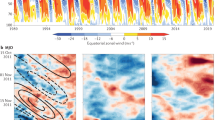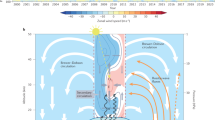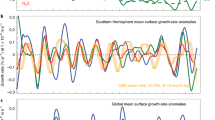Abstract
The zonal wind in the tropical stratosphere switches between prevailing easterlies and westerlies with a period of about 28 months1. In the lowermost stratosphere, the vertical structure of this quasibiennial oscillation (QBO) is linked to the mean upwelling2,3,4, which itself is a key factor in determining stratospheric composition. Evidence for changes in the QBO have until now been equivocal, raising questions as to the extent of stratospheric circulation changes in a global warming context. Here we report an analysis of near-equatorial radiosonde observations for 1953–2012, and reveal a long-term trend of weakening amplitude in the zonal wind QBO in the tropical lower stratosphere. The trend is particularly notable at the 70-hectopascal pressure level (an altitude of about 19 kilometres), where the QBO amplitudes dropped by roughly one-third over the period. This trend is also apparent in the global warming simulations of the four models in the Coupled Model Intercomparison Project Phase 5 (CMIP5) that realistically simulate the QBO. The weakening is most reasonably explained as resulting from a trend of increased mean tropical upwelling in the lower stratosphere. Almost all comprehensive climate models have projected an intensifying tropical upwelling in global warming scenarios5,6,7, but attempts to estimate changes in the upwelling by using observational data have yielded ambiguous, inconclusive or contradictory results8,9,10. Our discovery of a weakening trend in the lower-stratosphere QBO amplitude provides strong support for the existence of a long-term trend of enhanced upwelling near the tropical tropopause.
This is a preview of subscription content, access via your institution
Access options
Subscribe to this journal
Receive 51 print issues and online access
$199.00 per year
only $3.90 per issue
Buy this article
- Purchase on Springer Link
- Instant access to full article PDF
Prices may be subject to local taxes which are calculated during checkout



Similar content being viewed by others
References
Baldwin, M. P. et al. The quasi-biennial oscillation. Rev. Geophys. 39, 179–229 (2001)
Saravanan, R. A multiwave model of the quasi-biennial oscillation. J. Atmos. Sci. 47, 2465–2474 (1990)
Kawatani, Y., Hamilton, K. & Watanabe, S. The quasi-biennial oscillation in a double CO2 climate. J. Atmos. Sci. 68, 265–283 (2011)
Watanabe, S. & Kawatani, Y. Sensitivity of the QBO to mean tropical upwelling under a changing climate simulated by an Earth system model. J. Meteorol. Soc. Jpn 90A, 351–360 (2012)
Butchart, N. et al. Simulations of anthropogenic change in the strength of the Brewer–Dobson circulation. Clim. Dyn. 27, 727–741 (2006)
Garcia, R. R. & Randel, W. J. Acceleration of the Brewer–Dobson circulation due to increases in greenhouse gases. J. Atmos. Sci. 65, 2731–2739 (2008)
McLandress, C. & Shepherd, T. G. Simulated anthropogenic changes in the Brewer-Dobson circulation, including its extension to high latitudes. J. Clim. 22, 1516–1540 (2009)
Engel, A. et al. Age of stratospheric air unchanged within uncertainties over the past 30 years. Nature Geosci. 2, 28–31 (2009)
Stiller, G. P. et al. Observed temporal evolution of global mean age of stratospheric air for the 2002 to 2010 period. Atmos. Chem. Phys. 12, 3311–3331 (2012)
Young, P. J. et al. Changes in stratospheric temperatures and their implications for changes in the Brewer-Dobson circulation, 1979–2005. J. Clim. 25, 1759–1772 (2012)
Kawatani, Y. et al. The roles of equatorial trapped waves and internal inertia–gravity waves in driving the quasi-biennial oscillation. Part I: Zonal mean wave forcing. J. Atmos. Sci. 67, 963–980 (2010)
Lindzen, R. S. & Holton, J. R. A theory of the quasi-biennial oscillation. J. Atmos. Sci. 25, 1095–1107 (1968)
Plumb, R. A. The interaction of two internal waves with the mean flow: implications for the theory of the quasi-biennial oscillation. J. Atmos. Sci. 34, 1847–1858 (1977)
Takahashi, M. Simulation of the stratospheric quasi-biennial oscillation using a general circulation model. Geophys. Res. Lett. 23, 661–664 (1996)
Hamilton, K., Wilson, R. J. & Hemler, R. Atmosphere simulated with high vertical and horizontal resolution versions of a GCM: improvement in the cold pole bias and generation of a QBO-like oscillation in the tropics. J. Atmos. Sci. 56, 3829–3846 (1999)
Quiroz, R. S. Period modulation of the stratospheric quasi-biennial oscillation. Mon. Weath. Rev. 109, 665–674 (1981)
Geller, M. A., Shen, W., Zhang, M. & Tan, W. W. Calculations of the stratospheric quasi-biennial oscillation for time-varying wave forcing. J. Atmos. Sci. 54, 883–894 (1997)
Salby, M. & Callaghan, P. Connection between the solar cycle and the QBO: the missing link. J. Clim. 13, 2652–2662 (2000)
Hamilton, K. On the quasi-decadal modulation of the stratospheric QBO period. J. Clim. 15, 2562–2565 (2002)
Taguchi, M. Observed connection of the stratospheric quasi-biennial oscillation with El Niño–Southern Oscillation in radiosonde data. J. Geophys. Res.. 115, D18120, http://dx.doi.org/10.1029/2010JD014325 (2010)
Garfinkel, C. I. & Hartmann, D. L. Effects of the El Niño – Southern Oscillation and the quasibiennial oscillation on polar temperatures in the stratosphere. J. Geophys. Res.. 112, D19112, http://dx.doi.org/10.1029/2007JD008481 (2007)
Butchart, N. & Scaife, A. A. Removal of chlorofluorocarbons by increased mass exchange between the stratosphere and troposphere in a changing climate. Nature 410, 799–802 (2001)
Solomon, S. et al. Contributions of stratospheric water vapor to decadal changes in the rate of global warming. Science 327, 1219–1223 (2010)
Naujokat, B. An update of the observed quasi-biennial oscillation of the stratospheric winds over the tropics. J. Atmos. Sci. 43, 1873–1877 (1986)
Hamilton, K., Hertzog, A., Vial, F. & Stenchikov, G. Longitudinal variation of the stratospheric quasi-biennial oscillation. J. Atmos. Sci. 61, 383–402 (2004)
Taylor, K. E., Stouffer, R. J. & Meehl, G. A. An overview of CMIP5 and the experiment design. Bull. Am. Meteorol. Soc. 93, 485–498 (2012)
Andrews, D. G., Holton, J. R. & Leovy, C. B. Middle Atmosphere Dynamics (Academic, 1987)
Karoly, D. J. et al. An example of fingerprint detection of greenhouse climate change. Clim. Dyn. 10, 97–105 (1994)
Dunkerton, T. J. & Delisi, D. P. Climatology of the equatorial lower stratosphere. J. Atmos. Sci. 42, 376–396 (1985)
Acknowledgements
This work was supported by the Japan Agency for Marine-Earth Science and Technology through its support of the International Pacific Research Center, by the Environment Research and Technology Development Fund (A-1201) of the Ministry of the Environment, Japan and by JSPS KAKENHI grant nos 23740363 and 24340113. This work was also supported by NASA (grant no. NNX07AG53G) and by NOAA (grant no. NA11NMF4320128), organisations that sponsor research at the International Pacific Research Center. We thank A. Noda, H. Tokinaga, M. Fujiwara, K. Miyazaki, M. Takahashi, T. Hirooka, K. Sato, H. Nakamura and Y. N. Takayabu for suggestions. We also thank O. Arakawa and N. Hirota for handling the CMIP5 data archive. We acknowledge the World Climate Research Programme's Working Group on Coupled Modelling, which is responsible for CMIP, and we thank the climate modelling groups for making available their model output. For CMIP, the US Department of Energy’s Program for Climate Model Diagnosis and Intercomparison provides coordinating support and led development of software infrastructure in partnership with the Global Organization for Earth System Science Portals. We also acknowledge the Data Integration and Analysis System (DIAS) Fund for National Key Technology from MEXT.
Author information
Authors and Affiliations
Contributions
Y.K. and K.H. analysed the data. K.H. and Y.K. wrote the manuscript.
Corresponding author
Ethics declarations
Competing interests
The authors declare no competing financial interests.
Supplementary information
Supplementary Information
This file contains Supplementary Text, Supplementary Figures 1-13 and Supplementary References. This file was replaced on 28 August 2013 in order to correct Supplementary Figures 3 and 9 and also to make minor changes to the text. Please see the Corrigendum, doi:10.1038/nature12528, which is associated with this paper. (PDF 8728 kb)
Supplementary Data
Sheet 1 shows the monthly mean zonal wind data provided by the Free Berlin University and Sheet 2 shows the monthly mean zonal wind data at 70 hPa provided by IGRA. (XLS 184 kb)
Rights and permissions
About this article
Cite this article
Kawatani, Y., Hamilton, K. Weakened stratospheric quasibiennial oscillation driven by increased tropical mean upwelling. Nature 497, 478–481 (2013). https://doi.org/10.1038/nature12140
Received:
Accepted:
Published:
Issue Date:
DOI: https://doi.org/10.1038/nature12140
This article is cited by
-
Representation of the Stratospheric Circulation in CRA-40 Reanalysis: The Arctic Polar Vortex and the Quasi-Biennial Oscillation
Advances in Atmospheric Sciences (2024)
-
A CEOF-based method for measuring amplitude and phase properties of the QBO
Climate Dynamics (2023)
-
Role of Stratospheric Processes in Climate Change: Advances and Challenges
Advances in Atmospheric Sciences (2023)
-
Impacts, processes and projections of the quasi-biennial oscillation
Nature Reviews Earth & Environment (2022)
-
Climatology of diablo winds in Northern California and their relationships with large-scale climate variabilities
Climate Dynamics (2021)
Comments
By submitting a comment you agree to abide by our Terms and Community Guidelines. If you find something abusive or that does not comply with our terms or guidelines please flag it as inappropriate.



